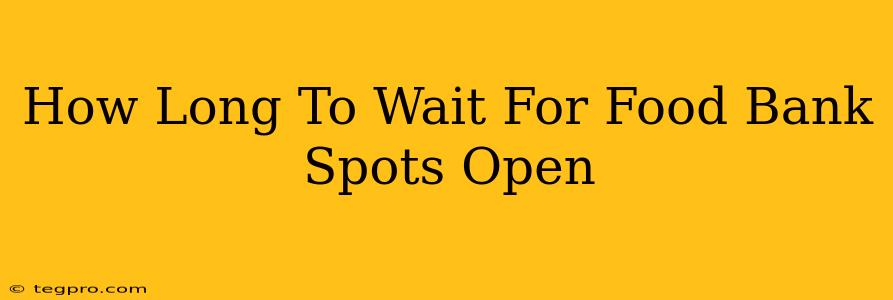Finding yourself in need of food assistance can be a stressful experience. Understanding how long you might wait for an open spot at a food bank is crucial for planning and managing your resources. Unfortunately, there's no single answer to this question; wait times vary significantly depending on several factors. This guide breaks down what influences wait times and offers tips to navigate the process effectively.
Factors Affecting Food Bank Wait Times
Several factors determine how long you might wait for a food bank appointment or to receive assistance:
-
Location: Highly populated urban areas with limited food bank resources often experience longer wait times than smaller towns with more readily available assistance. Demand significantly impacts availability.
-
Time of year: Demand tends to increase during holidays or economically challenging periods, leading to longer wait times. Similarly, times of natural disaster or widespread hardship can cause significant increases in demand.
-
Specific Food Bank: Individual food banks have different operating procedures, staffing levels, and available resources. Some may operate on a first-come, first-served basis, while others use appointment systems or prioritize individuals based on specific criteria (such as family size or income level).
-
Your Needs: The type and quantity of food assistance you require might impact the processing time. Complex cases might require more time for assessment and allocation of resources.
-
Application Process: Some food banks require extensive paperwork or pre-screening processes. These additional steps can add to the overall wait time.
Understanding the Application Process
While wait times vary, understanding the typical application process can prepare you for what to expect. Many food banks require you to:
- Provide Identification: You will likely need to present a valid government-issued ID.
- Proof of Address: Showing proof of your current residence is often necessary.
- Income Documentation: Income verification might be required to determine eligibility. This could involve pay stubs, tax returns, or other relevant financial records.
- Household Size Information: Food banks need to understand the number of people relying on their services to allocate resources appropriately.
Tips for Minimizing Wait Times
While you can't control all factors affecting wait times, you can take steps to streamline the process:
- Call Ahead: Contacting the food bank directly is the most effective way to understand current wait times and their specific application process.
- Check their Website: Many food banks have websites with updated information about their services, hours of operation, and any special instructions.
- Be Prepared: Gather all necessary documentation before your appointment or visit. This will significantly expedite the process.
- Explore Alternative Resources: If one food bank has a long waiting list, research other nearby options. Consider community pantries, soup kitchens, or other charitable organizations providing food assistance.
- Volunteer: Volunteering at a food bank allows you to better understand their operations and build a rapport, potentially speeding up the process for your own assistance in the future.
Don't Give Up!
Facing food insecurity is challenging, and navigating the system for assistance can feel overwhelming. Remember that food banks are dedicated to helping those in need. By being proactive, prepared, and persistent, you can increase your chances of accessing the support you need in a timely manner. Don't hesitate to reach out to local social services or community organizations for guidance if you need additional support.

